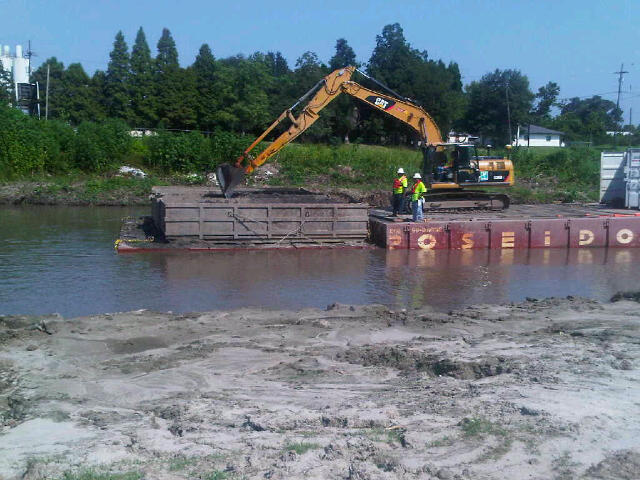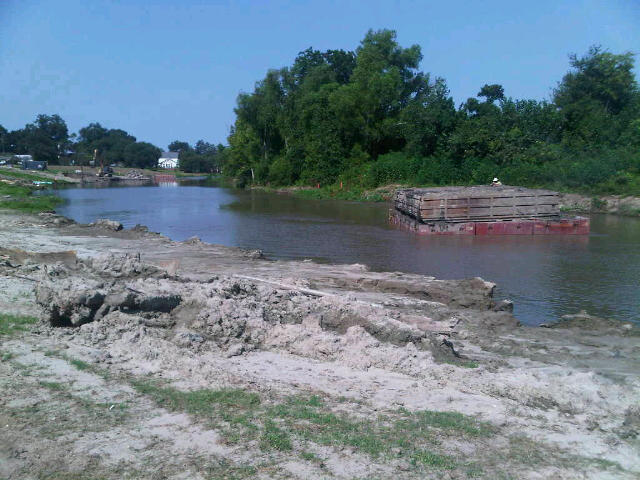
A variety of techniques are used to regulate the flow of freshwater diversions to ensure that water and sediment reach needed areas. These techniques maximize the benefits of freshwater diversions and can involve regulating water levels and direction of water flow to increase the dispersion and retention time of fresh water, nutrients, and sediment in the marsh. The water flow may be regulated by a combination of gates, locks, weirs, canal plugs, and gaps cut in artificial levee banks.
Bayou Lafourche
Bayou Lafourche was cut off from the flow of the Mississippi River in 1903. The bayou was partially reconnected to the river in the 1950’s with the installation of a pump/siphon station which currently averages approximately 200 cubic feet per second (cfs). Historically, the river served to counteract subsidence in the area by introducing fresh water, sediments, and nutrients. Project features include a receiving intake structure at the point of diversion in the Mississippi River; a pump/siphon system with a combined discharge capacity of 1,000 cfs; a discharge settling pond/sediment basin in Bayou Lafourche at Donaldsonville; modification of weir structures; bank stabilization along Bayou Lafourche; monitoring stations; and dredging of Bayou Lafourche.
PROJECT UPDATE
Mississippi River Reintroduction into Bayou Lafourche: To continue on with the progress made in Phase 1, in 2012 the State, through CPRA, allocated to the Bayou Lafourche Fresh Water District (BLFWD) $20 million of Coastal Impact Assistance Program (CIAP) funds for the Mississippi River Reintroduction to Bayou Lafourche Project (State Project BA-0161). This project, which has come be known as Phase 2, began in April 2013 when T. Baker Smith, LLC (TBS) was contracted by BLFWD to provide professional services for the implementation of the project. The purpose of this project is to implement features and improvements identified by and in accordance with the Final Phase 2 Design Report determined to be the most beneficial in order to improve the capacity of Bayou Lafourche to allow for increased flows through the bayou to benefit the Terrebonne and Barataria Basins through reductions in the salinities and/or nourishment of wetlands with the introduction and distribution of sediment and nutrients from the river.
In May 2015, BLFWD awarded a $15 million construction contract for Phase 2’s dredging.
BLFWD is also progressing with the partnership with the railroad to initiate a new design for the railroad bridge in Donaldsonville, a major obstacle to increasing flow into the bayou.
Freshwater: In November 2012, the voters of Lafourche, Assumption, and Ascension approved a 20-year, 2.11 millage renewal for the Bayou Lafourche Freshwater District by an overall 73% approval rating.
Terrebonne’s 40-year contract with the Bayou Lafourche water district expires in 2014. The parish now pays 3 cents per 1,000 gallons under the 1974 contract, or about $20,000 annually. Cost could jump to as high as 35 cents per 1,000 gallons, more than 10 times the current rate.
Terrebonne Parish voters approved a new 2.11-mill property tax on the May 4 2013 ballot, which is a requirement for Terrebonne to join the Bayou Lafourche Freshwater District, which supplies the parish with 80 percent of its drinking water. Terrebonne Parish will now bring 4 additional members to the BLFWD board, two representing north of the GIWW and two south of the GIWW.
